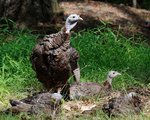With the Thanksgiving holiday taking place last week, many of us still have turkey on our mind. If we dined on turkey, it was probably the domestic-farm-raised turkeys bought from the store, though …
Stay informed about your community and support local independent journalism.
Subscribe to The River Reporter today. click here
This item is available in full to subscribers.
Please log in to continue |


With the Thanksgiving holiday taking place last week, many of us still have turkey on our mind. If we dined on turkey, it was probably the domestic-farm-raised turkeys bought from the store, though some of us could have feasted on wild turkey harvested by a lucky hunter in the family. Either way, it was likely a tasty meal, especially with all the trimmings. Maybe you strolled through a nearby field or forest to walk off that big dinner.
If so, you may have spotted a flock of the wild variety of turkeys or some sign of them; they leave footprints in the snow that are one behind the other, each of the three forward toes about 45 degrees apart and the rear one pointing perfectly behind. Patches of scraped leaf litter can be seen in the woods or on trails where a flock of turkeys have moved through, foraging for acorns or other mast. You may even see them in the backyard doing the same thing, probably stealing a few acorns that grey squirrels had buried.
Turkeys are abundant now in the region, but it wasn’t always like that. Market hunting and other methods started over a century ago reduced the population to a low of a few thousand turkeys in Pennsylvania during the early 1900s. Pennsylvania, like many other states, initiated proactive methods to help the wild turkey recover to its former range and numbers. Hunting regulations were implemented and turkey releases took place. In the 1960s, a method called “Trap and Transfer” was used. It involved trapping turkeys where their population was plentiful and transporting them to areas of sparse population. Today, there are between 300,000 and 400,000 turkeys in Pennsylvania.
It is no longer hard to find turkeys as it was in the early 1900s. They are frequently seen in forests or your backyard. Hens can be heard calling as they move as a flock, even if they are too far away to see. In the early mornings or evenings, you may spot a flock as they roost in a tall pine tree. In the spring, you will hear the males calling for a mate, the “spring gobbler” call drawing the attention of female turkeys and hopeful hunters alike.
I hope you all had a good Thanksgiving and that you get to enjoy turkeys out in the field as well as you enjoyed the one on the table.
Comments
No comments on this item Please log in to comment by clicking here